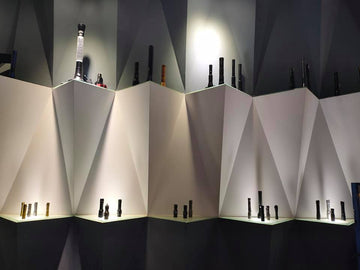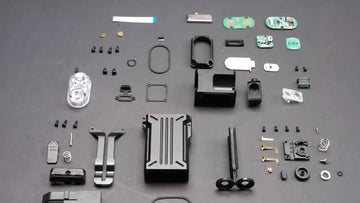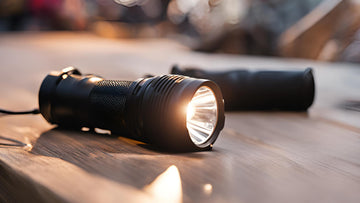What's the difference between 'lumens', 'candela', 'lux' and 'throw'?
Jan 25, 2022

What's the difference between 'lumens', 'candela', 'lux' and 'throw'?
Having the correct flashlight for the correct job is important. Using a 5 lumens keychain torch for search and rescue probably won't help much and using a 12000 lumens flood torch (such as the Wuben A9) is going to be more than what you need for when locking a gate at night. So let's look at some important torch related definitions:
What is a Lumen?
Lumens (lm) is a measurement of how much light is emitted in all directions. More lumens means more brightness. Approximate examples: birthday candle-1 lumen, phone flashlight-80 lumens, 40 watt incandescent (filament) bulb-460 lumens, 60 watt incandescent bulb- 800 lumens, 4 foot 32 watt T8 tube light-2500 lumens, HID car headlight-3000 lumens. (This means that the Wuben A9 is 4 times brighter than a HID car headlamp!)
On a bright day, in a hot country, each square metre outdoors has approximately 133,200 lumens. The Sun itself is 3.62×10^28 lumens i.e. 36,200 trillion-trillion lumens! That's why you can't directly look at it!
Enjoy a 15% discount on all Wuben X series products, including X0, X1, X2, and X3.
|
Light source |
Approximate brightness in lumens |
|
Key chain flashlight |
5 |
|
Bedroom nightlight |
10 |
|
Standard candle |
12 |
|
3xD cell Maglite flashlight |
80 |
|
1xAA LED flashlight |
100 |
|
2xAA LED flashlight |
250 |
|
40 watt tungsten bulb |
500 |
|
60 watt tungsten bulb |
800 |
|
Halogen car headlight |
1000 |
|
100 watt tungsten bulb |
1600 |
|
4-foot tube 32 watt T8 |
2500 |
|
HID car headlight |
3000 |
What are candelas?
Candelas (cd) help with understanding how focussed and intense the light source is. Candelas measure light intensity in only 1 direction.
A higher candela rating indicates a longer beam distance because more intense light travels further. High candela rated torches are good for visibility in smoke and fog and if you want a concentrated beam.
If you want an evenly illuminated area, with a less bright spot and do close up work, like reading a map, a flashlight with a lower candela rating is for you!
Approximately 1 candela = 12.57 lumens
Lumen ratings do not consider the spread of the light being emitted in degrees, whereas candela ratings do. For example, a standard fluorescent lighting device that emits a wide-spread beam can have a rating of 1,700 lumens and 135 candelas. But if the light emitted from this apparatus is narrowed and made to shine within a 20-degree beam, then its candela value will increase to 18,000.
The term candela is derived from abbreviating the phrase 'candle power'. It is a measure of intensity, rather than brightness. Lumens and candela get confused like 'voltage' does with 'current'. In simple terms, more intense light (higher candela) will travel further than weaker intensity light (lower candela).
The intensity of light reduces according to the 'inverse square' law. This means that if you shine a flashlight on an object 20 meters away and then shine it on an object 10 meters away (half the distance), the nearer object will be 2^2 (2 squared) times brighter i.e. 4 times brighter.
Long distance flashlights with a concentrated beam spot have higher candela than floodlights which spread the beam.
What is Lux?
Lux (lx) is used to measure light on a particular surface. Lux changes depending on how far this surface is from the light source. This means that the lux on the surface from the same flashlight will increase when the flashlight is shone close to it (and decrease when the light source further away).
'Lux' is another way of measuring light intensity. It is an abbreviation of 'luminous flux'. One lux is equal to one lumen per square meter (lux = lumens/m^2). For example, full daylight has around 10,000 lux, an overcast day, 1000 lux, full moon, 0.1 lux and quarter moon, 0.01 lux. Lasers have lower lumens but high lux, so throw very far (but with a very small beam). Floodlights have higher lumens, but lower lux, so don't throw as far (but light up wide areas). Lux changes by the distance the lit up area is from the light source.
BUT as flashlights are designed to be carried and not stay in a fixed position, lux can be overlooked when considering the best flashlight for you. Lux is disregarded when considering flashlights because the same flashlight will give different lux values depending upon of its distance from the surface and not because of its output brightness.
What is throw?
Throw is the maximum flashlight beam distance. Throw can be calculated from candela:
Throw = (√candela)x2
E.g. a 1 million candela torch has (√1000,000)x2 = 1000x2 = 2000 metres
Light output (Lumens) vs. peak beam intensity (Candela)
Higher output looks like it should mean higher intensity, but a light with more lumens isn't necessarily 'brighter'. This is because light output depends upon by the total amount of light coming from the front of the flashlight and is related to the bulb's efficiency. Peak beam intensity (higher candela rating) represents brightness perceived by the eyes. It is related to how focussed the beam is.
A tube light has high output but low intensity (a flood beam) and a laser pointer and has a low output but high intensity (a spot beam).They are both useful for their intended purpose, but neither of them would make a good torch.
The candela per lumen (cd/lm) ratio can be used to determine if a flashlight has spot or flood beam. Spot beams have a large cd/lm ratio. They are useful for lighting up distant objects. At close range, the beam may be too bright.
Flood beams have a small cd/lm ratio and are great for close-up tasks such as map reading. They will have less range to see distant objects.
- Work lights are normally less than 10 cd/lm
- Tactical flashlights are normally between 20-100 cd/lm
- Well focused spot beams are normally 100 cd/lm
Peak beam intensity vs. perceived brightness
Doubling light intensity does not mean that the object will appear twice as bright e.g. 12,000cd will not appear to be twice as bright as 6,000cd. This is because human perception of light is non-linear.
An approximation for peak beam intensity comparisons is that for a light to appear twice as bright, four times the intensity is needed, so a 4000cd flashlight will need a light source with 16000cd to appear to be twice as bright.





Hi , Great explanation for the different terms. Appreciate a clarification though. Under Candela, it’s written ‘’It is a measure of intensity, rather than brightness’‘.Couple of paragraphs below it also says ’’The intensity of light reduces according to the ‘inverse square’ law. This means that if you shine a flashlight …. the nearer object will be 2^2 (2 squared) times brighter i.e. 4 times brighter’’. So my query is : Are the terms intensity and brightness are the same or different?
Hope you can clarify. Thanks
Regards
Wow, thanks, good to know!!